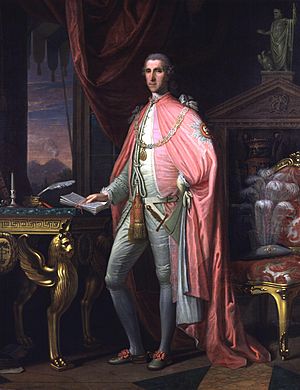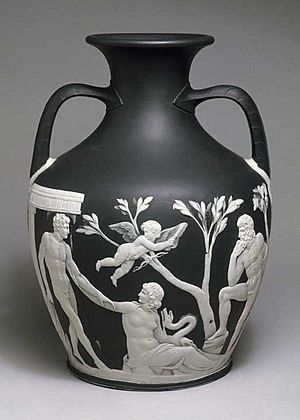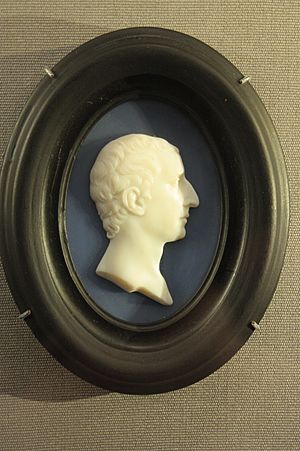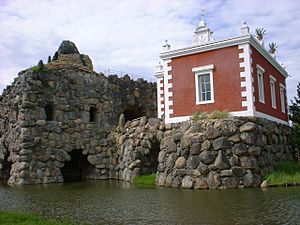William Hamilton (diplomat) facts for kids
Quick facts for kids
Sir William Hamilton
|
|
|---|---|
 |
|
| Envoy Extraordinary to the Kingdom of Naples | |
| In office 1764–1800 |
|
| Monarch | George III |
| Preceded by | Sir James Gray |
| Succeeded by | Sir Arthur Paget |
| Member of Parliament for Midhurst |
|
| In office 1761–1764 |
|
| Preceded by | Sir John Peachey |
| Succeeded by | Bamber Gascoyne |
| Personal details | |
| Born | 13 December 1730 London or Park Place, Berkshire, England |
| Died | 6 April 1803 (aged 72) London, England |
| Resting place | Slebech, Wales |
| Spouses | |
| Education | Westminster School |
| Occupation |
|
Sir William Hamilton (born December 13, 1730 – died April 6, 1803) was an important British diplomat, politician, and expert in ancient history and volcanoes. He worked as the British ambassador to the Kingdom of Naples (a country in Italy) from 1764 to 1800.
Before becoming a diplomat, he was a member of the British Parliament from 1761 to 1764. While living in Italy, Hamilton became very interested in studying local volcanoes and collecting ancient artifacts. He was recognized for his work and became a member of the Royal Society, a famous group for scientists. He also received the Copley Medal for his scientific contributions. His second wife was Emma Hamilton.
Contents
Early Life and Career

William Hamilton was born on December 13, 1730, in England. His father was Lord Archibald Hamilton, who was a governor of Jamaica. His mother was Lady Jane Hamilton. William grew up with George III, who later became King of Great Britain. They were so close that George III called William his "foster brother."
When he was nine, William went to Westminster School. He made many friends there who would be important throughout his life. William knew he needed to make his own way in the world. So, at age 16, he joined the army as an ensign. He served in the Netherlands and became a lieutenant in 1753.
In 1758, he left the army. He married Catherine Barlow, whose father was a Member of Parliament. William and Catherine loved music and were very happy together. Catherine inherited land in Wales, which gave them a steady income. Catherine passed away in 1782.
In 1761, William Hamilton became a Member of Parliament. He soon became interested in becoming the ambassador to Naples. In 1764, he was appointed to this important role.
Life in Naples

William Hamilton arrived in Naples on November 17, 1764. His official title was Envoy Extraordinary to the Kingdom of the Two Sicilies. He stayed in Naples as ambassador until 1800. His job was to report to the British government and help British businesses in Naples. He also hosted many English travelers.
These duties left him plenty of time to explore his interests. He loved art, ancient objects, and music. He also developed a new passion for studying volcanoes and earthquakes. The mild climate of Naples helped his wife Catherine, who had not been in good health.
The Hamiltons lived in a large home called Palazzo Sessa. Here, they hosted official events and William kept his growing collections of art and ancient items. They also had other homes, including a small villa by the sea and a house near Mount Vesuvius where he could study the volcano.
Collecting Ancient Vases
As soon as he arrived in Naples, Hamilton started collecting ancient Greek vases and other old artifacts. He bought them from dealers, other collectors, and even found some by opening ancient tombs himself.
In 1766–67, he published a book with pictures of his collection. It was called Collection of Etruscan, Greek, and Roman antiquities. This book helped spread knowledge about these ancient items. In 1771, he sold his first collection to the British Museum for a large sum of money.
The potter Josiah Wedgwood was inspired by the pictures in Hamilton's books. He used them to create beautiful pottery designs. In 1772, Hamilton was made a Knight of the Order of the Bath. He also became a member of the Society of Antiquaries of London, a group dedicated to studying the past.
Later, Hamilton brought a famous Roman glass vase to England. It was known as the Portland Vase. He sold it to the Duchess of Portland, and it also inspired Josiah Wedgwood's designs. This vase is now in the British Museum.
In 1798, as Hamilton was leaving Naples, he sent his art and a second vase collection back to England. Sadly, a small part of this collection was lost when the ship HMS Colossus sank. The remaining part of the collection was later bought by Thomas Hope, a banker.
Studying Volcanoes
Soon after Hamilton arrived in Naples, Mount Vesuvius started showing signs of activity. In 1766, he sent a report about an eruption, including drawings and samples, to the Royal Society in London. Because of this report, he was elected a Fellow of the Royal Society.
In 1767, there was an even bigger eruption. Hamilton sent another report, and both papers were published in the Royal Society's journal. In 1770, the Royal Society gave him the Copley Medal for his paper about a trip to Mount Etna.
In 1772, he published his writings on volcanoes in a book called Observations on Mount Vesuvius, Mount Etna, and other volcanos. This was followed by another book in 1776, Campi Phlegraei (meaning "Flaming fields"). This book had beautiful illustrations by Pietro Fabris. Hamilton also hired a priest to keep a daily diary of notes and sketches of Vesuvius. He was also interested in earthquakes and wrote a paper about the 1783 earthquake in Calabria.
Love for Music

The Hamiltons loved music and often held musical events at their home. William played the violin, and Catherine played the harpsichord or piano. They played with their servants or professional musicians.
The young Mozart and his father met the Hamiltons during their trip to Italy in 1770. Catherine played the harpsichord for Mozart, and he was very impressed. Another musician, Charles Burney, stayed with them and Hamilton helped him with his research. Burney thought Catherine was the best harpsichord player in Naples.
Catherine Hamilton passed away in August 1782. William was very sad. He wrote to his niece, saying he would "for ever feel the loss of the most amiable the most gentle and virtuous companion."
Second Marriage to Emma
A year after Catherine's death, Hamilton visited Britain. He met Emma Hart, who was a close friend of his nephew, Charles Greville.
When Hamilton returned to Naples, he felt lonely. Charles Greville later arranged for Emma to join Hamilton in Naples. Emma arrived on her 21st birthday in April 1786, with her mother. They were given an apartment and tutors to teach Emma Italian and singing. After some time, Emma became Hamilton's partner.
Hamilton and Emma married five years later, on September 6, 1791, in London. Hamilton had to ask the King's permission because of his public job. The wedding was quiet. The next day, Hamilton became a member of the Privy Council, a group of advisors to the King.
For most of Hamilton's time as ambassador, Naples was a peaceful place. But when France declared war on Britain in 1793, things became more difficult. Hamilton's role became more important, even as his health was getting worse.
Nelson's fleet arrived in Naples in 1798 after winning a big battle against the French. Nelson stayed as a guest with the Hamiltons. At the end of the year, the King and Queen of Naples had to leave because the French army was advancing. The Hamiltons went with them to Palermo in Sicily.
Later Life

In 1799, Naples was taken back from the French. Hamilton, the King and Queen, and Nelson stayed in Palermo. Hamilton wanted to return to Britain. In early 1800, a new ambassador replaced him. The Hamiltons and Nelson traveled overland back to England, arriving on October 31, 1800.
Hamilton lived in retirement for two and a half more years. He spent time fishing, visiting his lands in Wales, selling paintings and vases, and attending his clubs. He passed away on April 6, 1803, in London. He left money for Emma and her mother. His lands in Wales went to his nephew, Greville.
Hamilton was buried next to his first wife, Catherine, in Slebech, Wales.
Honoring Sir William Hamilton
- The author Susan Sontag wrote a novel about Hamilton's life called The Volcano Lover: A Romance.
- In the 1941 movie That Hamilton Woman, the actor Alan Mowbray played Sir William Hamilton.
- In Germany, there is a special garden called the Dessau-Wörlitz Garden Realm. It has an island with a model of Mount Vesuvius. The Duke who owned the garden would create fireworks that looked like a volcano erupting. At the bottom of the mountain, there is a building that looks like Hamilton's villa in Naples.
- The artist Walton Ford created a painting called Jack on his Deathbed. It shows the death of Hamilton's pet monkey in 1780.





